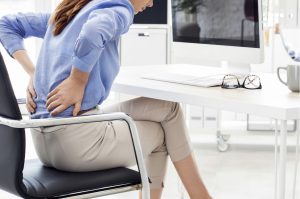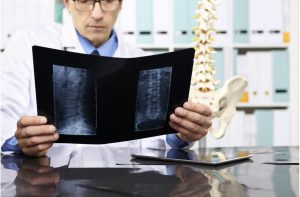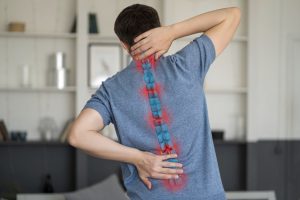Slipped Disc
Many individuals experiencing back or neck pain will refer to this pain as a “slipped disc.”
Although this is a common term that is even used by medical professionals, it does not represent the official diagnosis. Instead, it generally describes a number of specific spine conditions that may include bulging discs, herniated discs, or spondylolisthesis. The term is deceptive because slipping is not involved; instead, in some cases, the firm outer shell of a spinal disc is forced outside of its normal boundary. In other cases, a disc will be said to “slip” if it develops a tear in its thick, multilayered wall.
If a disc tear happens, some of the disc’s gel-like inner core material (nucleus pulposus) can potentially escap[e the confines of the disc wall and seep into the spinal canal. Also known as herniated, ruptured, or bulging discs, slipped discs can occur in the cervical (upper), thoracic (middle), and lumbar (lower) regions of the spine.
Causes
Certain individuals may be more at risk for developing a slipped disc. The most common cause of this condition is the natural degeneration of the spine. With age, the spinal discs lose their protective water content, leaving the bones to become brittle and rub against one another. As a result, they can slip more easily out of place.
Other risk factors include:
- Heavy lifting
- Being overweight
- Weak muscles
- Sedentary lifestyle
- Injury
Treatments
In a large number of cases, slipped disc symptoms are treatable using conservative therapies. After consulting with your doctor, they will suggest different options that could be effective and control your symptoms. Some conservative treatment options include:
- Stretching and controlled exercise
- Lifestyle changes
- Ice and heat application
- Corticosteroid injections
- Anti-inflammatory drugs
For patients who experience severe pain several weeks after beginning conservative treatment, they could be a candidate for surgery.
Symptoms
A slipped disc does not always result in any symptoms. In fact, the discomfort will only arise if displaced soft tissue irritates the damaged wall or compresses a sensitive spinal nerve or root of the spinal cord itself. The nature and location of the symptoms will depend on the size of the damaged disc. A slipped disc in the lumbar spine can cause tingling, numbness, muscle weakness, and spasms that radiate from the lower back through the buttocks, hips, legs, and feet. In other cases, a damaged disc in the cervical spine can lead to slipped disc symptoms in the neck, shoulders, arms, and hands. Slipped discs and other degenerative spine conditions often affect the lumbar region of the spine, which supports much of the body’s weight and therefore is especially prone to damage from the effects of ongoing wear and tear.
In rare cases, patients may experience paralysis, bowel dysfunction, or bladder dysfunction, which indicates a life-threatening medical emergency called cauda equina syndrome that must be treated immediately.
Diagnosis
Slipped disc symptoms are often similar to those of other back conditions. To find the most effective treatment option, it is important to get a proper diagnosis. Your doctor can diagnose your condition by conducting a physical examination and exploring your complete medical history. An X-ray, CT scan, or MRI may be necessary to rule out other conditions.
An important part of the diagnostic process is the question and answer session. While family medical history is an essential part of determining the cause of back pain and other slipped disc conditions, one of the most vital pieces of data you can supply to your doctor is information concerning the symptoms themselves. For instance:
- When did they first occur?
- What physical activity might have triggered them?
- Are there physical actions, such as leaning forward over a shopping cart or lifting a heavy object, that seem to exacerbate or reduce the pain?
- How would you gauge the severity of the symptoms?
These questions and other specific symptoms can help your doctor pinpoint the precise cause of your issues. The more you can tell your doctor about your condition, the more helpful it is.
Surgical Options
Minimally invasive spine surgery can provide lasting relief for patients dealing with a slipped disc – such as the outpatient procedures provided by BEST Health System. Our minimally invasive surgeries can treat a range of spine conditions using muscle-sparing techniques and offering a shorter recovery time.
Reach out to BEST Health System
If you have been diagnosed with a herniated disc, you do not have to suffer in pain. Connect with the dedicated healthcare professionals at BEST and get started on your road to recovery.
Related Articles
The New Way Patients Are Finding Relief from Chronic Back Pain
Living with Chronic Back Pain Living with chronic back pain can be incredibly challenging, and can impact your life in countless ways. Chronic back pain, […]
Can Sports Injuries Cause a Slipped Disc?
Understanding the Causes of Slipped Discs Among the many causes of slipped discs in the spinal column, participation in sports is a leading contributor. Athletes […]
Nonsurgical Treatments for a Slipped Disc
Living with a Slipped Disc Nonsurgical options to treat pain and impaired movement caused by a slipped disc are usually recommended before surgery becomes a […]
Can You Treat a Slipped Disc?
Slipped Discs and Treatment Slipped disc treatment options fall into two main categories: conservative and surgical. Doctors recommend that patients try conservative methods before considering […]
Slipped Discs - A Comprehensive Guide
Slipped Disc Overview If you have been diagnosed with a slipped disc, you may be confused about the information you found upon researching this condition. […]
What is Spondylolisthesis? Understanding Causes and Treatment
Spondylolisthesis comes from the Greek terms for “spine” and “slipping,” so it literally means spinal slipping. It can be a fairly common cause of spinal […]
Slipped Disc or Herniated Disc – What’s the Difference | BEST
Whether you call it a slipped disc, slip disc, disc slip, bulging disc, or herniated disc, back pain and other symptoms from any condition related […]
Is "Slipped Disc" a Real Condition?
Many people who experience neck pain, back pain, leg pain, and other symptoms describe the source of pain as a “slipped disc.” Although this is […]







